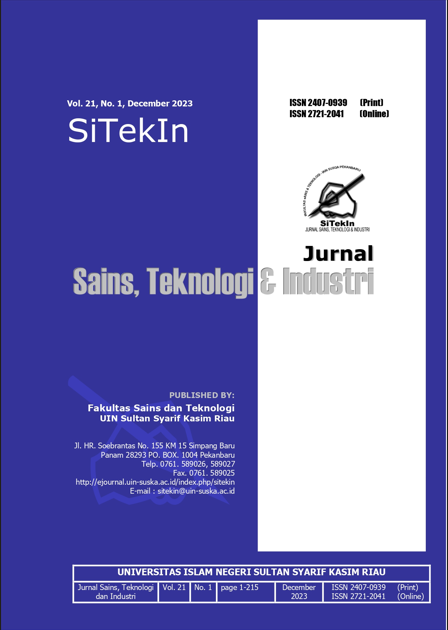Student Perceptions of Andalas University Payakumbuh Campus Against the Speed of Access to Academic Information Systems
DOI:
https://doi.org/10.24014/sitekin.v21i1.23247Abstract
The need for information continues to grow rapidly such as the need for an Academic Information System, where Academic Information System is an innovation of technology and information. This happens because of the demands of the times that require information to be transferred quickly. To find out how fast information reaches users who are the main goal, the parameters used are bandwidth and signal strength. The access speed of an information system network is one of the dimensions that is very important for users of the information system. The results of the study state that the Academic Information System of Andalas University access is quite good at normal usage times, but often hangs or errors at peak usage times, both access is done with a computer or laptop or with a smartphone.
References
P. Mittal, “A multi-criterion decision analysis based on PCA for analyzing the digital technology skills in the effectiveness of government services,” in 2020 International Conference on Decision Aid Sciences and Application (DASA), 2020, pp. 490–494.
G. G. Gable, D. Sedera, and T. Chan, “Re-conceptualizing information system success: The IS-impact measurement model,” J. Assoc. Inf. Syst., vol. 9, no. 7, p. 18, 2008.
T. R. Fakhrurrasi, A. Adriansyah, S. Budiyanto, J. Andika, S. Haryanti, and U. A. Rachmawati, “Load balance optimization in peer classifier robin method as hybrid from peer connection classifier and round robin methods,” J. Eng. Sci. Technol., vol. 16, no. 3, pp. 2528–2543, 2021.
X. Shuping, Y. Hongqing, Y. Fan, and W. Yajuan, “The Design of Remote Control System Based on the Embedded Web Server,” Int. J. Adv. Network, Monit. Control., vol. 6, no. 1, pp. 41–49, 2021.
A. E. Khedr, A. M. Idrees, and R. Salem, “Enhancing the e-learning system based on a novel tasks’ classification load-balancing algorithm,” PeerJ Comput. Sci., vol. 7, p. e669, 2021.
A. Vichare and S. Verma, “Embedded web server for home appliances,” Int. J. Eng. Res. Appl., pp. 190–193, 2012.
J. W. Creswell, Educational research: Planning, conductiong, and evaluationg quantitative and qualitative research, 4th ed. Boston: Pearson Education, Inc, 2012.
J. Cohen, Statistical power analysis for the behavioral sciences. New York: Lawrence Erlbaum Associates, 1988.
A. S. Bahri, K. Saefullah, and M. Anwar, “The effect of firm size and leverage on financial performance and their impact on firm value in food and beverage sector companies listed on the indonesia stock exchange,” J. Bus. Stud. Manag. Rev., vol. 5, no. 2, pp. 208–214, 2022.
F. Pohan, I. Saputra, and R. Tua, “Scheduling Preventive Maintenance to Determine Maintenance Actions on Screw Press Machine,” J. Ris. Ilmu Tek., vol. 1, no. 1, pp. 1–12, 2023.
I. N. Permadi and D. B. Nisa, “A Model Experiment Design Using the Taguchi Method: A Case Study Of Making Concrete Roof,” J. Ris. Ilmu Tek., vol. 1, no. 1, pp. 36–44, 2023.
E. A. Kadir, S. L. Rosa, A. Syukur, M. Othman, and H. Daud, “Forest fire spreading and carbon concentration identification in tropical region Indonesia,” Alexandria Eng. J., vol. 61, no. 2, pp. 1551–1561, 2022.
D. Kandris, C. Nakas, D. Vomvas, and G. Koulouras, “Applications of wireless sensor networks: an up-to-date survey,” Appl. Syst. Innov., vol. 3, no. 1, p. 14, 2020.
G. Filhaq, S. Aprianto, and H. Alfianto, “Design of Smart Locker Door Using Quality Function Deployment Based on ATMega 2560 Microcontroller,” J. Ris. Ilmu Tek., vol. 1, no. 1, pp. 25–35, 2023.
T. M. Sari and W. Dini, “Risk Assessment and Mitigation Strategy in The Halal Broiler Supply Chain,” J. Ris. Ilmu Tek., vol. 1, no. 1, pp. 13–24, 2023.
T. Hu, N. Chitnis, D. Monos, and A. Dinh, “Next-generation sequencing technologies: An overview,” Hum. Immunol., vol. 82, no. 11, pp. 801–811, 2021.
A. Fuller, Z. Fan, C. Day, and C. Barlow, “Digital twin: Enabling technologies, challenges and open research,” IEEE access, vol. 8, pp. 108952–108971, 2020.
C. Bai, P. Dallasega, G. Orzes, and J. Sarkis, “Industry 4.0 technologies assessment: A sustainability perspective,” Int. J. Prod. Econ., vol. 229, p. 107776, 2020.
W. D. Hoyer, M. Kroschke, B. Schmitt, K. Kraume, and V. Shankar, “Transforming the customer experience through new technologies,” J. Interact. Mark., vol. 51, no. 1, pp. 57–71, 2020.
A. A. Abdullayev, “System of information and communication technologies in the education,” Sci. world Int. Sci. J., vol. 2, pp. 19–21, 2020.
N. Mostoli, M. Rostamy- Malkhalifeh, A. Shahverani, and M. H. Behzadi, “Using the Malmquist Index in Evaluation Process to Enhance Mathematical Literacy in High School Students,” Int. J. Assess. Tools Educ., vol. 6, no. 4, pp. 636–655, 2019, doi: 10.21449/ijate.623080.
D. S. Holcomb and G. F. Cunningham, The Vision of the Future of Obstetrics & Gynecology, An Issue of Obstetrics and Gynecology Clinics, E-Book, vol. 48, no. 4. Elsevier Health Sciences, 2021.
Downloads
Published
Issue
Section
License
This work is licensed under a Creative Commons Attribution-ShareAlike 4.0 International License
Copyright Notice
An author who publishes in the SITEKIN Journal agrees to the following terms:
- Author retains the copyright and grants the journal the right of first publication of the work simultaneously licensed under the Creative Commons Attribution-ShareAlike 4.0 License that allows others to share the work with an acknowledgement of the work's authorship and initial publication in this journal
- Author is able to enter into separate, additional contractual arrangements for the non-exclusive distribution of the journal's published version of the work (e.g., post it to an institutional repository or publish it in a book) with the acknowledgement of its initial publication in this journal.
- Author is permitted and encouraged to post his/her work online (e.g., in institutional repositories or on their website) prior to and during the submission process, as it can lead to productive exchanges, as well as earlier and greater citation of the published work (See The Effect of Open Access).
Read more about the Creative Commons Attribution-ShareAlike 4.0 Licence here: https://creativecommons.org/licenses/by-sa/4.0/.

